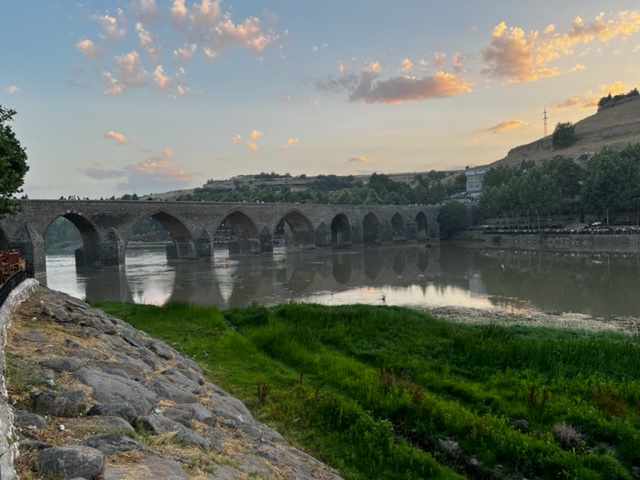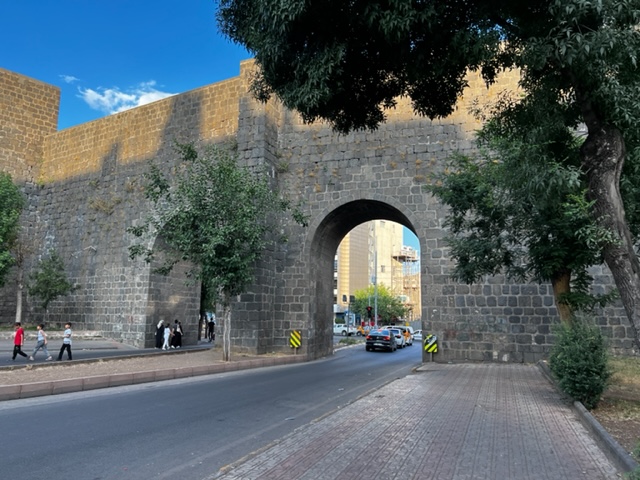
Nathan Young tells a tale of two Lausanne centennial celebrations: one in Diyarbakır, the other in Ankara.
.
Nathan is lecturer at the Ohio State University and Visiting Researcher at METU in Ankara.
Last summer, while spending nearly a month in the city of Diyarbakır, Turkey, I talked to locals about the significance of their republic’s upcoming October 29th centennial celebration. Unsurprisingly, their perspectives on the expected festivities accompanying the hundredth anniversary of the republic’s founding were not positive. One interlocutor commented, “Whenever something like this occurs, you know, the 100th anniversary, the 90th anniversary, the 80th anniversary, et cetera, for us, it’s painful. It is pain for us…Because we do not internalize it…this is what a rival identity, a rival Turkish identity wants to impose on us.” For the Kurdish community in southeast Turkey, this “imposition of Turkish identity” as an official policy began with the Treaty of Lausanne. Though my ethnographic work had been specifically focused on the national centennial, I became aware that other anniversaries were also being brought to the fore in order to reexamine, reassess, and reconceptualize the historical record, including the ratification of Lausanne on July 24, 1923.
During my time in Diyarbakır, I became acquainted with local lawyer Rıdvan Dalmış, who along with a colleague represents the Kurdish Diaspora Convention, Diakurd. These two lawyers have been prosecuting a case against the Turkish government on behalf of Diakurd. Their legal action harnesses the moment of the Treaty of Lausanne’s centennial to draw attention to what they regard as injustices resulting from its passage. “The agreement accepted in Lausanne has resulted in the confiscation of all rights of the Kurds as a nation,” they argue. In contrast to the preceding Treaty of Sèvres (1920), Lausanne did not designate a geographical region for an autonomous Kurdistan. Thus, for the Kurdish community of Turkey, Lausanne is definitively an event to be mourned, not celebrated.
A few weeks later, I attended an event at the city’s chamber of commerce entitled “Conference on the Future of Kurdistan at the Centennial of the Lausanne Treaty” [Lozan Antlaşması’nın 100 Yılında Kurtdistanın Geleceği Konferansı]. At least one hundred individuals, basically all men, packed the place to the rafters. As I was jostled into the large meeting space on the third floor, two details on the video screens grabbed my attention. First, the conference title was rendered in Kurdish (the Kurmanci dialect) as well as in Turkish. Second, the Kurdish flag was featured, notably supplanting its Turkish counterpart, ubiquitous at every other venue I had ever entered. Two prominent scholars, İsmail Beşikçi and Mehmet Bayrak, were in attendance. Both have spent time investigating issues surrounding the “Kurdistan Problem” [Kürt Sorunu]; both have been arrested and detained for their controversial publications. The flag, the title written in Kurmanci, and the presence of Beşikçi and Bayrak created a discursive space within a space—a local environment (the conference room) in a regional context (Diyarbakır) where Kurdish pasts, presents, and futures could be considered.

TEN ARCHES BRIDGE, DIYARBEKIR
A few weeks later I attended another event titled “The Workshop on the Problems of the Turks Living in Greece at the Centennial of the Lausanne Peace Treaty” [Lozan Barış Antlaşması’nın 100. Yılında Yunanistan’da Türklerinin Sorunları Çalıştayı]. It was held in the capital city, at Ankara University’s Institute of Turkish Revolutionary History [Türk İnkılap Tarihi Enstitüsü]. Speakers during the first panel considered the plight of Turkish communities living on the Greek islands of Rhodes and Kos [Rodos and İstanköy]. The second panel of speakers were concerned with Turks living in Western Thrace [Batı Trakya]. This portion of the Thrace geographical region is under Greek rather than Turkish sovereignty.
The Ankara event manifested the long-standing conviction that islands near their nation’s western coast (some even visible from the mainland) should belong to Turkey, not Greece. There has been collective disappointment that Atatürk did not fight for these islands, either militarily or at the negotiating table. Lausanne, it is thought, saved Turkey for Turks. But why had Lausanne not gone further: Why not the islands, too? Why not a larger portion of Thrace? After all, ethnic Turks then lived (and currently live) in those locations. Atatürk had been successful in maintaining a small foothold in Europe—essential for advancing the narrative for Turkey as a European nation. But he didn’t press farther. The Greeks had erred tactically when their armies pushed too far into Anatolia. Over-extending their supply lines, they were driven backwards to Izmir and off the peninsula. Perhaps mindful of this military blunder, Atatürk didn’t make a similar mistake regarding the Aegean islands or broader Thrace. Yet the desire for increased territory remains, enhanced by demographic evidence: Turkish communities exist in these places, but under a “foreign power.”
Despite the sharp contrast between these two events in Diyarbakır and Ankara, some fundamental concerns were strikingly similar. Both events utilized the hundredth anniversary of the Lausanne Treaty to revisit topics critical to the historical trajectory of nation-state formation. Perhaps more significantly, both events examined injustices believed to be enshrined through the terms of Lausanne and perpetuated for decades—and now a century. In the first instance, the issue at stake was the future of the Kurdish-majority areas in southeastern Turkey. The speakers believed that Lausanne stripped the Kurds of the promise of an independent state. In the other, however, the well-being of Turks living in Greece was the primary concern. Interestingly, the event held in Ankara included the word “peace” in the title (Lausanne Peace Treaty); in Diyarbakır, the verbiage was simply “Lausanne Treaty”. For those celebrating the Republic of Turkey, Lausanne is lauded as bringing peace on an international scale by formally ending British, French, and Italian designs on Anatolia. For the Kurds of Turkey, Lausanne demarcates a period of domestic acrimony and strife extending to the present. The strictures and stipulations of Lausanne began in 1923. They remain “alive and well” in 2024.
MAIN IMAGE: COURTESY OF NATHAN YOUNG
Blogposts are published by TLP for the purpose of encouraging informed debate on the legacies of the events surrounding the Lausanne Conference. The views expressed by participants do not necessarily represent the views or opinions of TLP, its partners, convenors or members.

